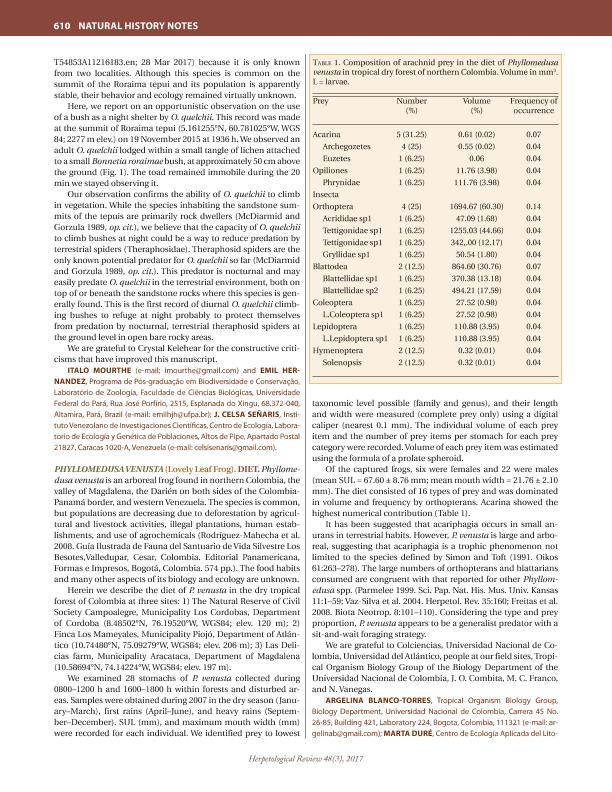Artículo
Phyllomedusa Venusta (Lovely Leaf Frog)
Fecha de publicación:
09/2017
Editorial:
Society for the Study of Amphibians and Reptiles
Revista:
Herpetological Review
ISSN:
0018-084X
Idioma:
Inglés
Tipo de recurso:
Artículo publicado
Clasificación temática:
Resumen
PHYLLOMEDUSA VENUSTA (Lovely Leaf Frog). DIET.Phyllomedusa venusta is an arboreal frog found in northern Colombia, the valley of Magdalena, the Darién on both sides of the ColombiaPanamá border, and western Venezuela. The species is common, but populations are decreasing due to deforestation by agricultural and livestock activities, illegal plantations, human establishments, and use of agrochemicals (Rodríguez-Mahecha et al. 2008. Guía Ilustrada de Fauna del Santuario de Vida Silvestre Los Besotes,Valledupar, Cesar, Colombia. Editorial Panamericana, Formas e Impresos, Bogotá, Colombia. 574 pp.). The food habits and many other aspects of its biology and ecology are unknown. Herein we describe the diet of P. venusta in the dry tropical forest of Colombia at three sites: 1) The Natural Reserve of Civil Society Campoalegre, Municipality Los Cordobas, Department of Cordoba (8.48502°N, 76.19520°W, WGS84; elev. 120 m); 2) Finca Los Mameyales, Municipality Piojó, Department of Atlántico (10.74480°N, 75.09279°W, WGS84; elev. 206 m); 3) Las Delicias farm, Municipality Aracataca, Department of Magdalena (10.58694°N, 74.14224°W, WGS84; elev. 197 m). We examined 28 stomachs of P. venusta collected during 0800–1200 h and 1600–1800 h within forests and disturbed areas. Samples were obtained during 2007 in the dry season (January–March), first rains (April–June), and heavy rains (September–December). SUL (mm), and maximum mouth width (mm) were recorded for each individual. We identified prey to lowest taxonomic level possible (family and genus), and their length and width were measured (complete prey only) using a digital caliper (nearest 0.1 mm). The individual volume of each prey item and the number of prey items per stomach for each prey category were recorded. Volume of each prey item was estimated using the formula of a prolate spheroid. Of the captured frogs, six were females and 22 were males (mean SUL = 67.60 ± 8.76 mm; mean mouth width = 21.76 ± 2.10 mm). The diet consisted of 16 types of prey and was dominated in volume and frequency by orthopterans. Acarina showed the highest numerical contribution (Table 1). It has been suggested that acariphagia occurs in small anurans in terrestrial habits. However, P. venusta is large and arboreal, suggesting that acariphagia is a trophic phenomenon not limited to the species defined by Simon and Toft (1991. Oikos 61:263–278). The large numbers of orthopterans and blattarians consumed are congruent with that reported for other Phyllomedusa spp. (Parmelee 1999. Sci. Pap. Nat. His. Mus. Univ. Kansas 11:1–59; Vaz-Silva et al. 2004. Herpetol. Rev. 35:160; Freitas et al. 2008. Biota Neotrop. 8:101–110). Considering the type and prey proportion, P. venusta appears to be a generalist predator with a sit-and-wait foraging strategy.
Palabras clave:
Phyllomedusa Venusta
,
Diet
,
Colombia
Archivos asociados
Licencia
Identificadores
Colecciones
Articulos(CECOAL)
Articulos de CENTRO DE ECOLOGIA APLICADA DEL LITORAL (I)
Articulos de CENTRO DE ECOLOGIA APLICADA DEL LITORAL (I)
Citación
Blanco Torres, Argelina; Duré Pitteri, Marta Inés; Bonilla, M. A.; Phyllomedusa Venusta (Lovely Leaf Frog); Society for the Study of Amphibians and Reptiles; Herpetological Review; 48; 3; 9-2017; 610-611
Compartir




